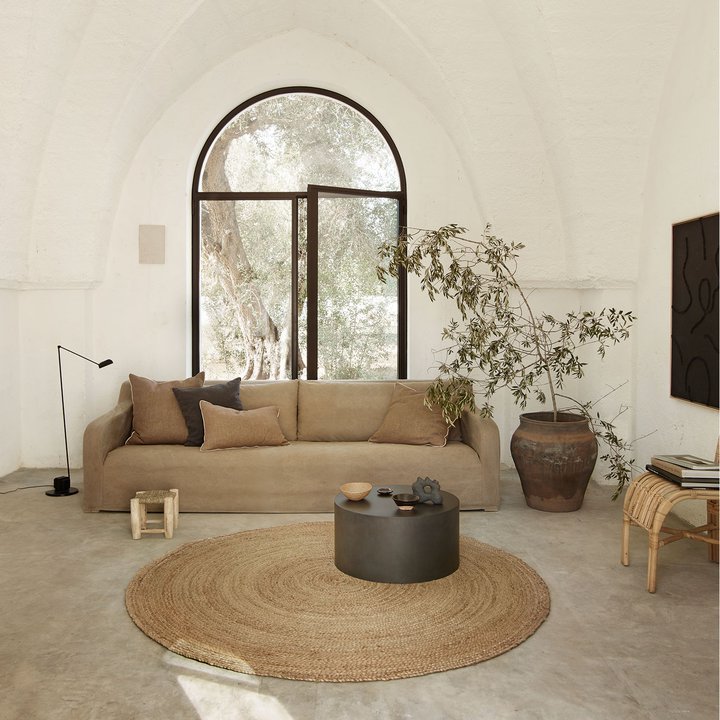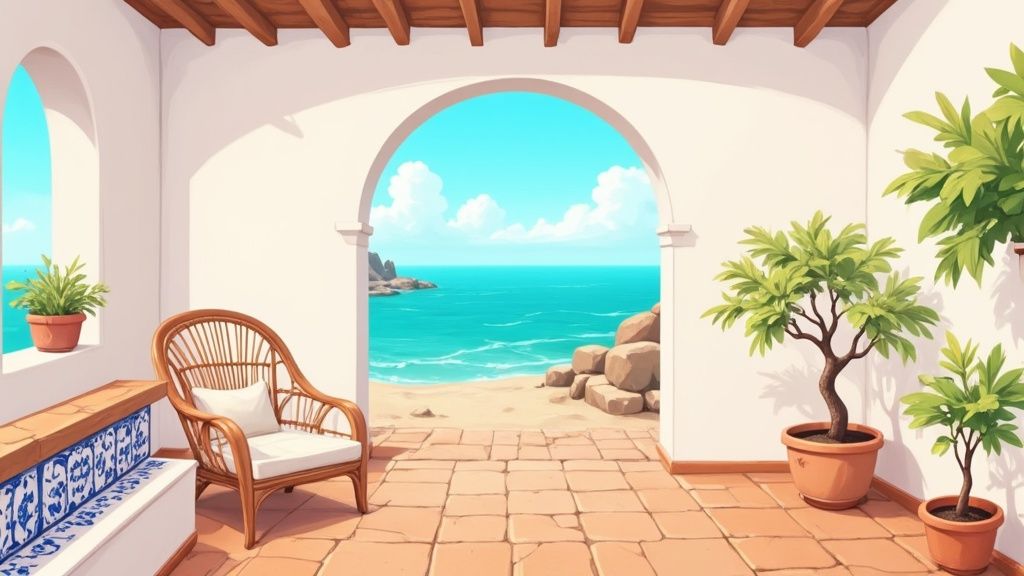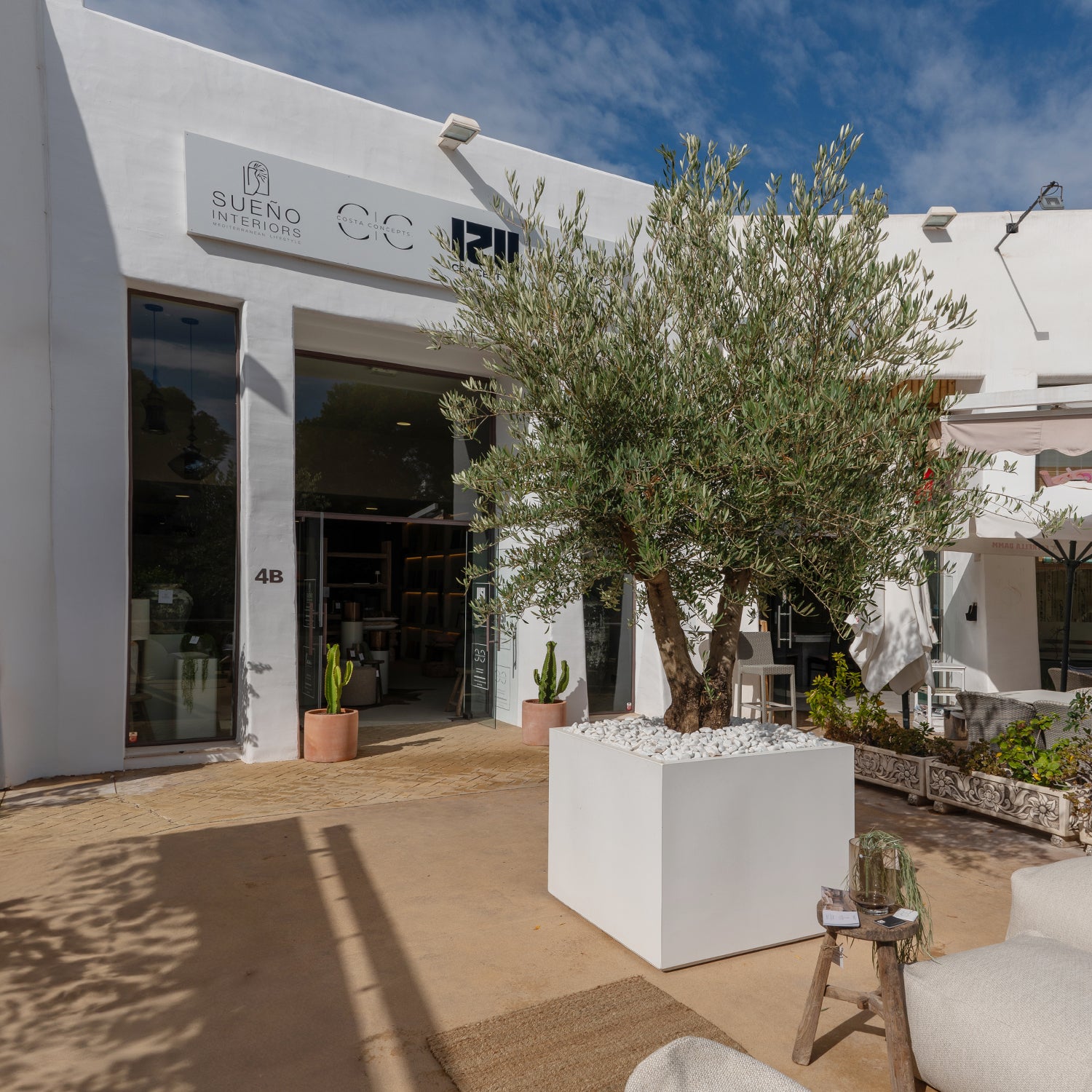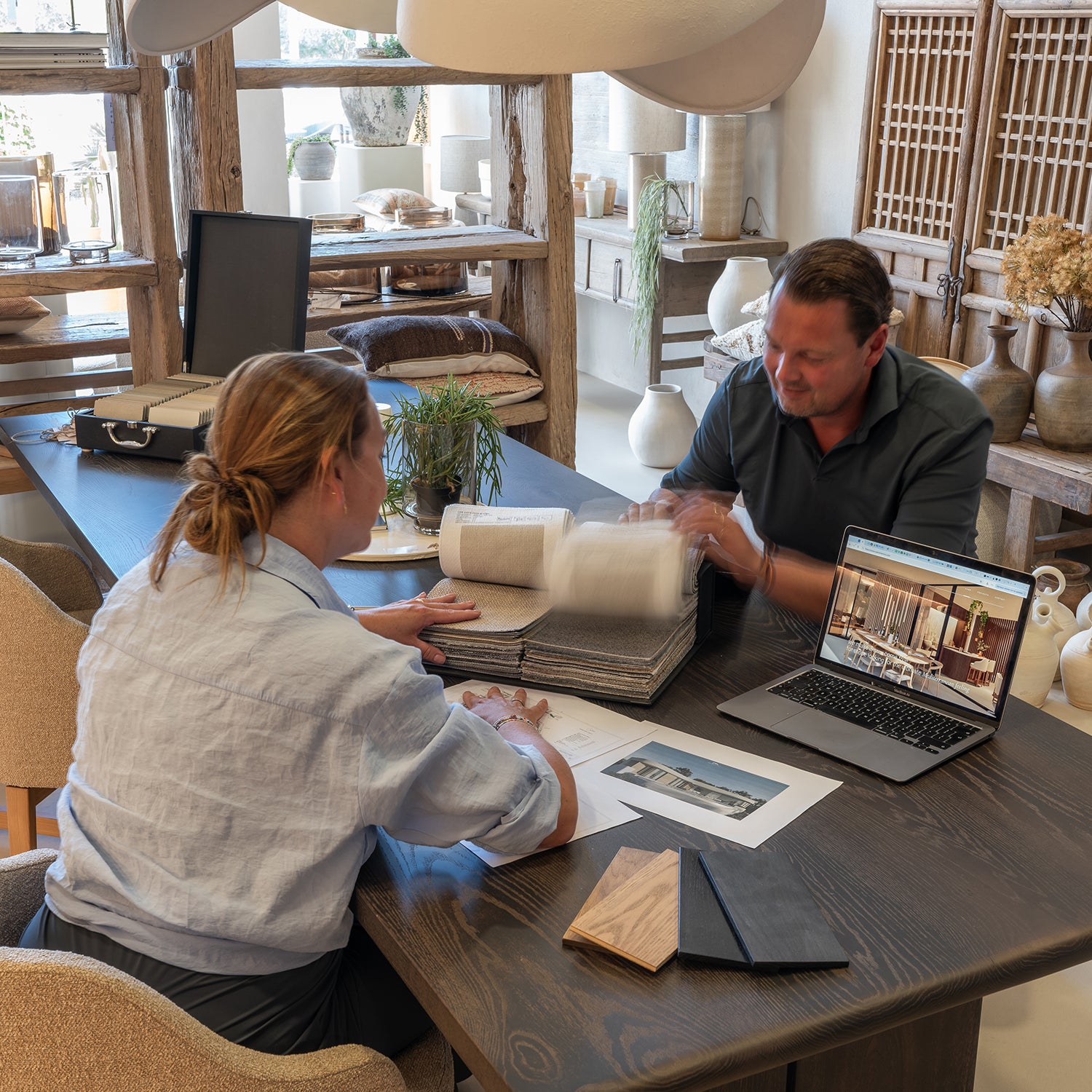Article: How to Plan a Home Renovation in Costa Blanca
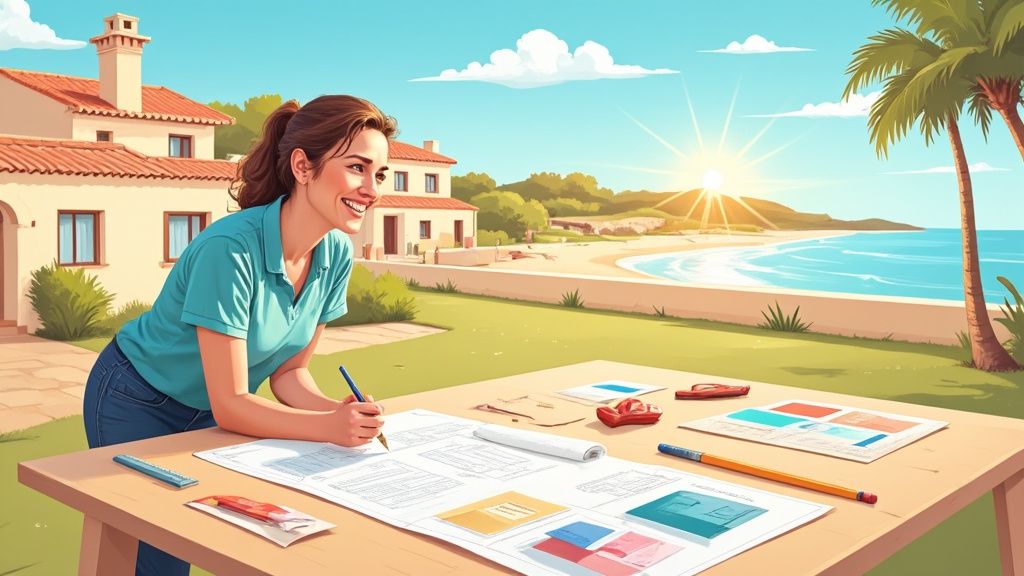
How to Plan a Home Renovation in Costa Blanca
Planning a home renovation isn't just a list of steps; it's a journey. To get it right, you need a clear, ordered process. It all starts by defining your vision, figuring out your absolute must-haves versus the nice-to-haves. From there, you'll set a realistic budget, flesh out the design, find a team you trust, and handle the local permits. Getting this groundwork right from the start is the secret to avoiding those nightmare mid-project changes and ending up with a space that truly fits your life.
Defining Your Costa Blanca Renovation Vision
Every great home renovation begins long before the first wall comes down. It starts with an idea. This initial stage is, without a doubt, the most important part of the entire process. It’s where you set the course for every single decision that follows.
This is the time to translate those daydreams—of a sun-drenched kitchen or a sprawling outdoor terrace—into a solid, workable plan. Without this foundation, projects tend to meander, budgets get blown, and the final result never quite feels right.
The first step is to ask some honest questions about your lifestyle. Forget aesthetics for just a moment and think about function. What frustrates you about your current layout? Are you desperate for more storage, craving better natural light, or dreaming of a seamless flow into your garden? Answering these questions is how you build a powerful project brief. To get professional input right from the start, we always recommend visiting our studio in Moraira to discuss these initial ideas.
Separating Needs from Wants
One of the best things you can do right now is grab a piece of paper and create two lists: your ‘needs’ and your ‘wants’. This simple exercise brings instant clarity and will be your best friend when comes to design choices and, crucially, budget control.
- Needs are your non-negotiables. These are the things that solve a real problem or meet a fundamental requirement. Think fixing a leaking roof, adding a downstairs bathroom for an elderly parent, or replacing outdated, unsafe wiring.
- Wants are the beautiful upgrades. These are the features that would be amazing to have but aren't strictly essential for the home to work. This is where your dream marble worktops, a high-end integrated sound system, or bespoke cabinetry come in.
Being brutally honest here is key. A brand-new, larger kitchen might feel like a need, but maybe the real need is simply better storage and a more efficient layout within the existing footprint. Making that distinction helps you prioritise where the money goes, ensuring your most important goals are met first.
Crafting Your Vision Board and Project Brief
With your priorities straight, it’s time to bring your vision to life, both visually and in writing. A vision board is a fantastic tool for this—you can go old-school with a corkboard or create one digitally on a platform like Pinterest. It's so much more than just a collage of nice pictures; it’s a way to spot the recurring themes in your taste. You might realise you’re constantly pinning images with natural materials, clean minimalist lines, or a specific colour palette. This becomes a powerful communication tool for your designer and contractors.
A well-defined project brief is your roadmap for the entire renovation. It should detail your goals, your needs-versus-wants list, how you need each space to function, and the aesthetic you've uncovered with your vision board. This document makes sure everyone is on the same page from day one.
Ultimately, this first phase is all about deep reflection. It’s about thinking how you want your Costa Blanca home to feel and function for many years to come. To truly see how these initial ideas can translate into reality, there's no substitute for experiencing materials and discussing possibilities with an expert. We warmly invite you to visit our studio in Moraira—you can touch the fabrics, see the finishes in person, and get professional input to help crystallise your vision right from the very start.
Creating a Realistic Renovation Budget
So, you’ve got a clear vision for your renovation. That’s the fun part. Now comes the moment that grounds those exciting ideas in reality: setting the budget. This isn't just about crunching numbers; it's about creating a solid financial roadmap for your project. A well-planned budget is what keeps the work on track, wards off nasty surprises, and ultimately ensures you end up with a home you love, without the financial headache.
It’s easy to throw a rough figure around, but a truly successful renovation plan goes much deeper. You need to think about every single potential cost, from the big-ticket items down to the smallest details. A great way to start is by visiting our studio in Moraira, where we can discuss your goals and provide initial cost estimates.
Think of it as your project's financial backbone. Getting this right gives you the control and confidence to move forward.
Deconstructing Renovation Costs
To build an accurate budget, you have to understand where the money actually goes. Many homeowners get fixated on the cost of materials—the beautiful tiles or the sleek kitchen worktops—but that’s only one piece of the puzzle. Labour, permits, and professional fees are just as significant and need to be factored in from day one.
Let's break down the main cost categories you'll be looking at:
- Materials and Finishes: This covers everything you can see and touch, from flooring and paint to appliances and light fittings. The quality and brands you select here will massively influence your spending.
- Labour Costs: This is what you pay the skilled tradespeople who make it all happen—your builders, plumbers, electricians, and painters.
- Professional Fees: Depending on the scale of your project, you might need an architect, an interior designer, or a structural engineer. Their expertise is an investment in getting the job done properly.
- Permits and Inspections: Your local council will require permits for certain types of work. These fees aren't huge, but they are non-negotiable for keeping your renovation compliant.
- Contingency Fund: This is your financial safety net. Trust me, unexpected issues almost always pop up. A contingency fund stops these surprises from derailing your entire project.
This chart gives a great visual of how homeowners often balance their initial renovation dreams against the practical necessities.
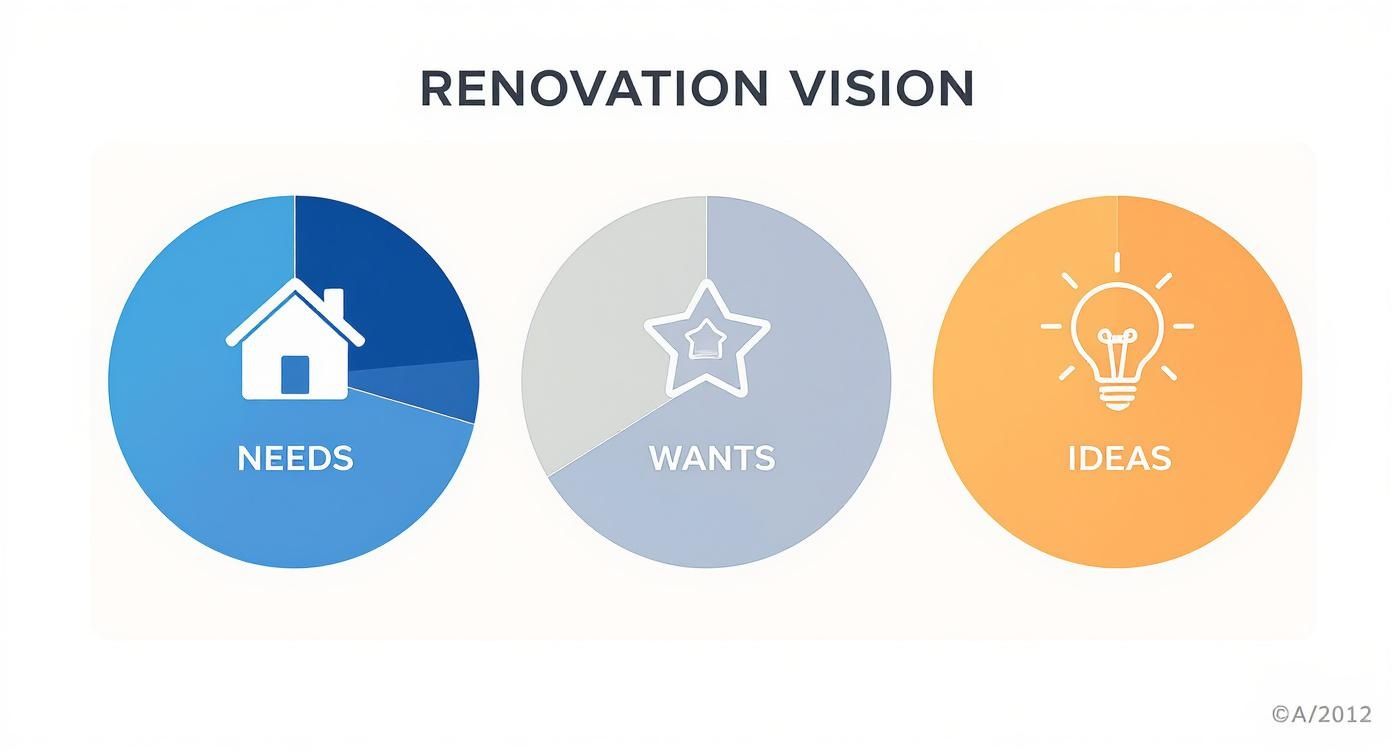
As you can see, while the exciting ideas are what get us started, a successful plan is always built on addressing the fundamental needs first.
Establishing Your Financial Framework
Once you know the categories, you can start assigning numbers. Here in the Netherlands, renovation costs can vary quite a bit, so careful planning is key. As a general rule of thumb, a turnkey renovation will typically set you back between €800 and €1,500 per square metre. This figure usually includes materials, labour, and basic design services.
A good way to start is by deciding on your absolute maximum spend. From there, you can work backwards, allocating percentages to each category based on your priorities.
Expert Tip: I can't stress this enough—always set aside a contingency fund of at least 15-20% of your total project cost. This isn't just "extra" cash. It’s an essential part of the budget for dealing with unforeseen challenges, like discovering hidden damp or realising the wiring needs a complete overhaul.
Speaking of which, understanding the potential cost of major jobs, like the true cost to rewire a house, is vital. This kind of foresight helps you allocate funds much more accurately and prevents you from being caught off guard by necessary—but often expensive—upgrades.
To give you a clearer idea, here’s how a budget might break down for a typical mid-range renovation project in the Netherlands.
Sample Renovation Budget Breakdown
| Expense Category | Percentage of Total Budget | Example Cost (€30,000 project) |
|---|---|---|
| Labour & Installation | 20-35% | €6,000 - €10,500 |
| Kitchen & Bathroom Fixtures | 15-20% | €4,500 - €6,000 |
| Flooring & Tiling | 10-15% | €3,000 - €4,500 |
| Electrical & Plumbing | 10-15% | €3,000 - €4,500 |
| Windows & Doors | 5-10% | €1,500 - €3,000 |
| Painting & Finishing | 5-10% | €1,500 - €3,000 |
| Permits & Professional Fees | 3-5% | €900 - €1,500 |
| Contingency Fund | 15-20% | €4,500 - €6,000 |
This table provides a general guideline. Your own percentages will shift based on whether your project is cosmetic or involves major structural changes.
Tracking and Managing Your Spending
Drafting the budget is just the first step. The real magic happens when you diligently track every euro spent. A simple spreadsheet or a budgeting app is perfect for this. Log every single expense as it happens, not a week later. This gives you a live snapshot of your project's financial health and helps you make smart decisions on the fly.
For instance, if you score a great deal on your floor tiles, you can consciously reallocate that saving to something on your "wish list," like those high-end taps you've been eyeing. On the flip side, if an unexpected plumbing issue eats up more of the budget, you'll know exactly how much to draw from your contingency fund. Juggling these moving parts is a core element of any renovation, and you can learn more about managing it all in our guide to interior design project management.
Ultimately, a realistic budget doesn’t limit your vision—it empowers it. It gives you the structure you need to make clever choices, stay out of debt, and confidently bring your dream home to life.
Developing Your Design and Sourcing Materials
Right, with your vision pinned down and a realistic budget in place, we get to the fun part: developing the design. This is where your abstract ideas and Pinterest boards start to become something real and tangible. It's the crucial step that translates your dream into a detailed plan your builders can actually work from.
This is all about getting into the nitty-gritty. "A more open feel" is a great starting point, but now it needs to become a precise floor plan, an electrical layout, and a list of specific materials. Nailing these details now is what saves you from expensive changes and headaches once the walls start coming down. A solid design plan ensures everyone is on the same page. Visiting our studio in Moraira is the perfect way to finalise these details with expert guidance.
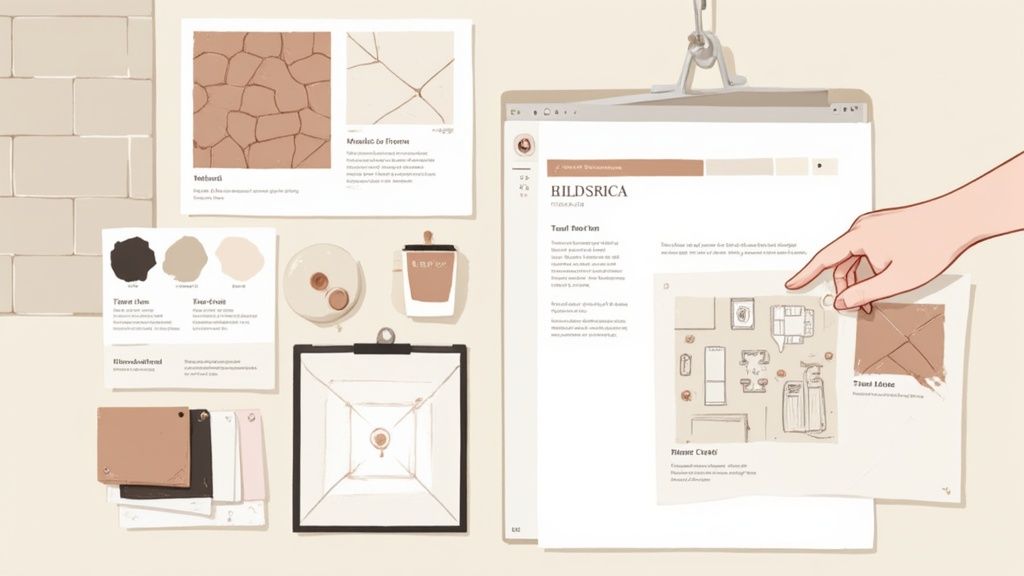
Visualising Your Future Space
Before a single tile is laid, you need to see your new space. This is where professional floor plans and 3D renderings are absolute game-changers. A 2D floor plan gives you the layout, but it's the 3D models that truly bring a project to life.
These digital visualisations let you:
- Get a true feel for the scale and proportion of the rooms, complete with furniture.
- See how the Spanish sunlight will move through the space at different times of the day, affecting colours and surfaces.
- Play around with different layouts and material combinations without spending a single euro.
- Catch potential problems early – like a door that opens the wrong way or a walkway that’s too narrow – before they become costly construction mistakes.
This process is the ultimate reality check, making sure the design doesn't just look good but actually works for the way you live.
The Crucial Task of Sourcing Materials
Choosing your materials, fixtures, and finishes is where you inject your personality into the home. It’s so much more than just picking a paint colour; you're selecting the very elements you’ll touch and see every single day. You have to think about durability and maintenance just as much as aesthetics.
Take flooring, for instance. That gorgeous, porous natural stone might look incredible, but is it a practical choice for a busy kitchen with kids and spills? Or would a hard-wearing porcelain tile be a smarter, more durable option in the long run? The same practical logic applies to everything from kitchen worktops to bathroom taps.
Your material choices should tell a cohesive story. Think about how the different textures and colours will flow from room to room, creating a unified and harmonious feel throughout your entire home.
And when you’re choosing these things for a home in Spain, the climate is a massive consideration. Your materials have to stand up to intense summer sun and humidity. To help you get this right, we've put together some advice on how the unique Costa Blanca climate impacts interior design choices. It’s essential reading for choosing materials that are not only beautiful but also built to last here.
The Power of a Tactile Experience
Digital renderings and online shops are brilliant tools, but they can't replace the experience of seeing and touching materials in person. You just can't appreciate the subtle texture of linen, the true colour of a stone worktop in natural light, or the solid feel of a brass handle from a screen.
This is exactly why we always encourage our clients to visit our studio in Moraira. Our concept store is a place where you can immerse yourself in the actual materials that will shape your home. You can feel the different wood finishes, compare tile textures, and see how fabrics drape. It's this physical connection that gives you the confidence to make the right choices.
Making these decisions in a curated space, with expert advice right there with you, takes the guesswork out of the equation. It turns an abstract plan into a real, personal experience, ensuring the final result is a home that truly feels like yours.
Assembling Your Renovation Dream Team
Now that you have a detailed design and your materials are sorted, it's time to focus on the people who will bring your vision to life. Let’s be honest: the success of your home renovation rests almost entirely on the quality of your team. This isn’t just about finding skilled tradespeople; it’s about building a solid partnership with professionals you genuinely trust to handle your investment with care and precision.
Choosing the right architects, designers, and contractors in the Costa Blanca is one of the biggest decisions you'll make. These are the people who will be in your home, managing your budget, and turning your dreams into a physical reality. Taking the time to assemble the right group is the best insurance policy for a smooth, successful project. A great first step is visiting our studio in Moraira to meet our team and see our work firsthand.
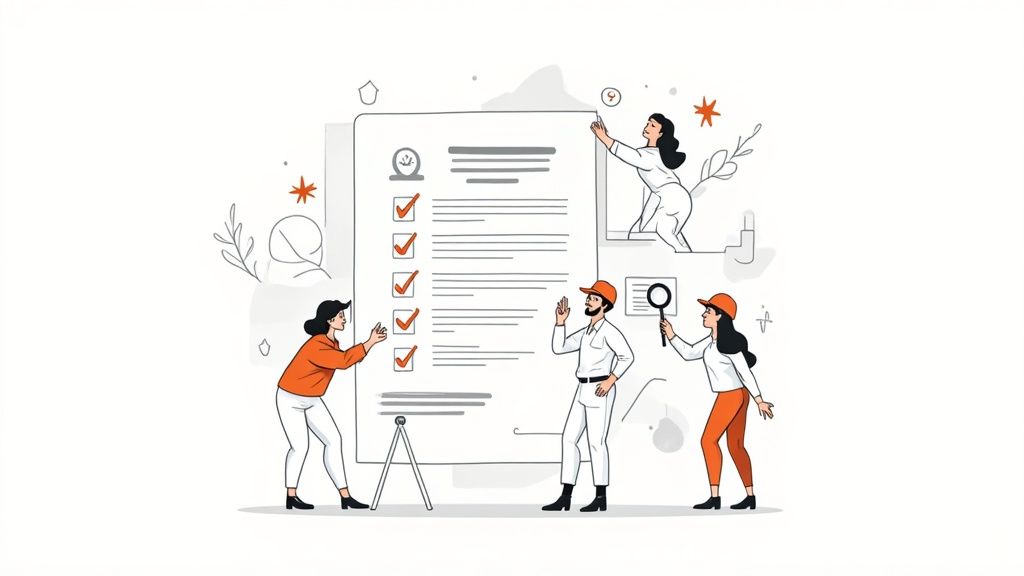
Vetting Professionals Like an Expert
Finding good people begins with good research. Please don't just go with the first name you're given or the cheapest quote you receive. A thorough vetting process now will save you countless headaches down the line.
First, check credentials and insurance. Any reputable professional will be more than happy to show you proof of their qualifications and liability coverage. Then, ask to see a portfolio of their recent work. You're looking for projects that feel similar in style and scope to yours—it's the best indicator they have the right experience.
But the real insight comes from talking to their past clients. Don't be shy. Ask about their communication style, how they handled unexpected challenges (because they always come up!), and whether they stuck to the timeline and budget. This kind of firsthand feedback is gold.
Design-Build Firm vs. Hiring Separately
You’ll come across a couple of different working models on the Costa Blanca. The right one for you really depends on your project's complexity and how hands-on you want to be.
- Hiring Specialists Separately: This is the traditional route where you hire an architect, then a contractor, and perhaps an interior designer. It gives you maximum control, but it also means you become the project manager, responsible for coordinating between everyone.
- Using a Design-Build Firm: This model gives you a single point of contact for both the design and the construction. It streamlines communication and often leads to a more efficient timeline, as the entire team works together from day one.
For many homeowners, the integrated approach of a design-build service is far less stressful. If you're someone who wants to manage every single detail, hiring separately might be a better fit. To see how an integrated team can transform a property, you can learn more about a successful house reform in Moraira and see the benefits of a cohesive approach.
Decoding Quotes and Contracts
When the quotes start coming in, don't just skim to the bottom line. A professional quote should be detailed and itemised, breaking down the costs for materials, labour, and any subcontracted work. Vague, one-line quotes are a massive red flag and often hide future "surprise" costs.
A detailed quote is a sign of a transparent and organised professional. It should clearly outline what is included—and just as importantly, what is not—to prevent misunderstandings later.
Once you’ve chosen your team, insist on a comprehensive, legally sound contract. This document is your ultimate protection. It needs to clearly state the full scope of work, a payment schedule tied to project milestones, the estimated start and completion dates, and a clear process for handling changes. A solid contract holds everyone accountable and ensures you're all working towards the same goal.
Getting to Grips with Local Renovation Trends and Rules
A great renovation plan is always grounded in its surroundings. Once you’ve got your designs sorted and your team lined up, the next step is to dive into the specific dynamics of the Costa Blanca property market. Tapping into regional trends isn’t just about making the process smoother; it can seriously boost your property’s value down the line.
Thinking locally means looking beyond your own four walls. It’s about making smart choices based on everything from which materials are readily available to what the housing market is demanding. A project that feels at home in its environment is always a better investment. The best way to get this local insight is by visiting our studio in Moraira, where we live and breathe Costa Blanca design.
The Shift Towards Sustainable and Energy-Efficient Homes
One of the biggest trends shaping renovations across the region is the move towards sustainability. More and more, homeowners are prioritising energy efficiency, partly to be kinder to the planet and partly to slash those rising utility bills. Building these elements into your renovation is a savvy, forward-thinking move.
Think about features that truly work with the Costa Blanca climate:
- High-performance glazing: Good quality windows might seem like a small detail, but they can dramatically reduce heat gain in the summer. This keeps your home naturally cooler and means you won’t have to rely so heavily on air conditioning.
- Solar energy solutions: With over 300 days of sunshine a year, installing solar panels is practically a no-brainer here. It’s one of the most popular and practical ways to bring down your energy costs.
- Water-saving fixtures: In an arid climate like ours, every drop counts. Fitting taps and showerheads designed to conserve water adds real value, both ecologically and economically.
These aren't just trendy upgrades anymore. They’re fast becoming standard expectations for buyers in the area, directly influencing your home’s future appeal and resale price.
Understanding the Local Market Pulse
The renovation sector here has been buzzing. It’s been spurred on by rising energy prices and government subsidies aimed at sustainability. In 2023, for instance, residential renovation work increased by around 6.5%, which shows just how strong the market is. With the Dutch government planning to add over 900,000 new homes by 2030, renovating existing properties is a huge part of meeting that demand sustainably. You can read a bit more in this analysis of the Dutch housing market.
This flurry of activity has a direct impact on your project. High demand can squeeze the availability of skilled tradespeople and drive up costs, which could throw a wrench in your timeline. It’s more important than ever to plan far ahead and get your build team locked in early.
Nothing Beats Hands-On Local Insight
Trying to navigate all these local nuances—from the latest design trends to the maze of building regulations—can feel like a lot to take on. Honestly, there's just no substitute for local expertise and the chance to actually see and touch the materials that perform best in this climate.
This is exactly why we always invite our clients to visit our studio in Moraira.
Coming to see us is about more than just browsing samples. We can sit down and talk about how current trends could work with your vision, explore materials that are perfect for the Mediterranean lifestyle, and give you the local knowledge you need to make decisions with confidence. It’s the best way to make sure your renovation plan isn’t just beautiful, but perfectly in tune with the Costa Blanca.
Integrating Smart Technology into Your Home
When you’re deep in renovation plans, it's easy to focus on the aesthetics right now—the perfect tile, the right paint colour. But a truly modern home thinks about the future, too. Integrating smart technology isn't just about adding a few cool gadgets; it’s about building a home that’s more intuitive, efficient, and secure from the ground up.
By weaving smart features into your initial plans, you avoid the massive headache and cost of trying to retrofit everything later. This is the time to decide where to run wiring for automated blinds, where to place sensors for intelligent lighting, or how to ensure you have rock-solid Wi-Fi in every corner of your property. It’s this hidden infrastructure that makes all the magic happen seamlessly.
Planning for a Connected Lifestyle
The possibilities with smart technology are incredibly practical and can genuinely make life easier. Imagine a home that anticipates your arrival, with a thermostat that has already learned your family’s schedule to perfectly heat or cool the space. Or a lighting system that subtly shifts its brightness and warmth throughout the day to support your natural body clock.
These systems are about much more than just convenience. They deliver real, tangible benefits that elevate your day-to-day living:
- Enhanced Security: Integrated cameras, smart locks, and sensor networks give you the power to monitor your property from anywhere in the world, offering complete peace of mind.
- Greater Energy Efficiency: Smart plugs can automatically shut down devices that sip power when idle, and automated systems can slash your energy consumption without you ever lifting a finger.
- Ultimate Comfort: Control your home's entire atmosphere—from the lights to the sound system—with a simple voice command or a quick tap on your phone.
The move towards this kind of tech is undeniable. Forecasts suggest that by 2029, over 72% of Dutch households will feature smart home technology. That’s a huge leap from just 22% in 2024, showing just how central these features are becoming to the modern home.
Making It All Work Together
The secret to a great smart home is ensuring everything talks to each other. You want all your different devices to communicate smoothly, which is where a central hub like Google Home or Apple HomeKit comes in. This unifies all the tech, creating a cohesive and effortless experience for you. To get a better sense of the possibilities, it's worth exploring what smart home automation can offer.
Visualising how you'll actually use this technology is so important. It can be hard to picture until you see it in action. That's why when you visit our studio in Moraira, we can show you exactly how these systems are integrated into a real-world design, helping you choose the perfect solutions for your own Costa Blanca home.
A Few Common Renovation Questions
Even with the best-laid plans, a few questions always pop up when you're about to embark on a home renovation. It’s completely normal. We’ve pulled together some of the most common queries we hear to give you clear, straightforward answers and help you move forward with confidence. The surest way to get all your questions answered is by visiting our studio in Moraira for a personal consultation.
How Long Will My Renovation Actually Take?
This is always the big question, and the most honest answer is: it really depends. Every project is unique. A simple cosmetic update to a single bathroom might only take 2-4 weeks. A full kitchen overhaul, however, often lands in the 6-12 week range.
For major reforms involving structural changes or a whole-house renovation, you’re likely looking at a timeline of 4 to 12 months, sometimes even longer.
Several key things influence the schedule:
- The Scope of Your Project: It sounds obvious, but the bigger and more complex the work, the longer it will take.
- Permit Approvals: Dealing with the local council (ayuntamiento) to get the necessary licences can sometimes add weeks to your pre-construction timeline. It's a crucial step that can't be rushed.
- Material Availability: If you’ve fallen in love with custom-ordered tiles from Italy or bespoke joinery, be prepared for longer lead times. These can significantly impact your start date.
- Contractor Schedules: The best professionals are almost always booked months in advance. Planning ahead is the only way to secure a spot in their diary.
Should I Move Out During the Work?
For smaller projects contained in one part of the house, like a guest bedroom, staying put is usually fine. But if the work involves your kitchen, main bathroom, or will create a lot of dust and noise, moving out is often the best decision for your own sanity and safety.
Living through a major renovation is incredibly disruptive. Moving out also gives the contractors freedom to work more efficiently, which can sometimes even shorten the overall timeline.
While it’s an added expense, having a peaceful, clean space to retreat to away from the construction zone is invaluable. It dramatically reduces the daily stress and protects your family from the constant disruption.
What's the Best Way to Finalise My Design Choices?
It’s easy to feel overwhelmed when it’s time to make final calls on finishes, colours, and textures. The best way to find clarity is to see and touch things in person. A tile might look one way on a website, but feeling its texture and seeing the true colour in natural light is a completely different experience.
This is where getting expert guidance really pays off. We always encourage clients to visit our studio here in Moraira. You can physically interact with all the material samples, see how different elements look together, and get personalised advice to lock in your vision with total confidence. It ensures every choice is one you'll still love years down the line.
Ready to turn your vision into a beautifully designed reality? Sueño Interiors is your partner in creating timeless, comfortable spaces on the Costa Blanca. Explore our services and book a consultation today. https://www.suenointeriors.com

